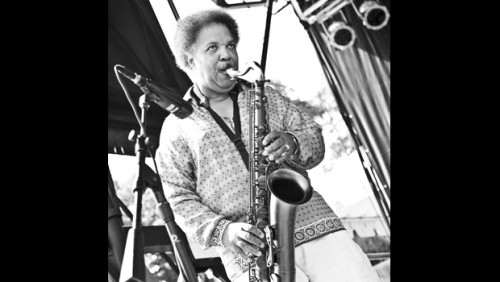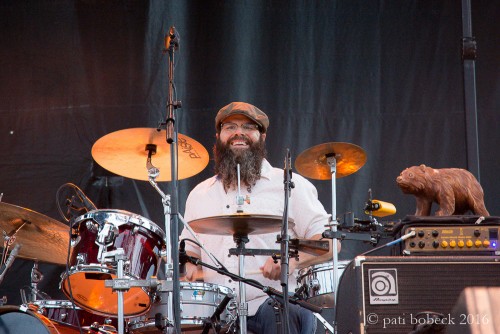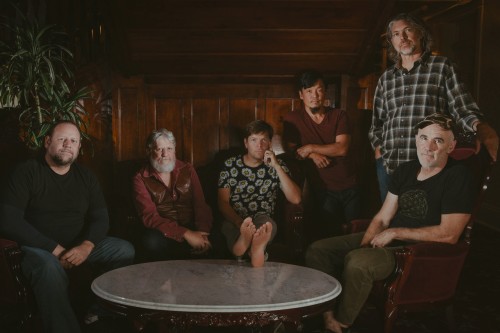By Michael Lester
Photo by Jason Riedmiller
Initiative, confidence and humility — along with the fuel of frustration fed by band members who jeered his unnecessarily loud sax playing back in junior high — all steered Ron Holloway to an unannounced visit to legendary jazz trumpeter Dizzy Gillespie’s dressing room at a club in Maryland back in 1977.
Holloway arrived at the cracked doorway of Gillespie’s dressing room, armed with a cassette recording of some of his playing. The jazz great graciously gave it a listen, liked what he had heard coming from the 24-year-old’s horn, and later invited Holloway to tour the world with him.
Several years after his pivotal meeting with Gillespie, Holloway’s drive scored him what, at the time, was an unthinkable gig: He sat in for an entire set of Jimi Hendrix covers with a guy named Stevie Ray Vaughan and his new band, Double Trouble.
Nearly four decades later, Holloway continues to crack open unlikely doors with his eclectic brand of sax, most recently as a member of the Warren Haynes Band and as a frequent collaborator with bluegrass-based Cabinet, which hosts its Susquehanna Breakdown Saturday, May 10, at Montage Mountain.
Holloway will roam the Breakdown grounds as “artist-at-large,” as he describes his role, figuring he’ll sit in with several bands, most notably the Scranton-based hosts.
To hear the 60-year-old Holloway tell the story of his fascinating, decorated and perhaps underrated music career, he strikes you as that under-the-radar guy back in high school who wouldn’t necessarily be invited to the A-list parties. He would none the less crash the party in hopes of making some friends in that polite way of his.
Once he starts to mingle, once people recognize his talent, he becomes a hit, the guy who’s always welcome to the next party.
An “open invitation” is how Holloway frequently refers to his welcome status with some of music’s biggest acts, particularly on the jam band scene.
Holloway and his tenor sax have gained those open invites over the years from the likes of Haynes, the Allman Brothers Band, Susan Tedeschi, Derek Trucks, Little Feat and Widespread Panic.
He toured internationally as a member of Tedeschi’s band, from 2005 to 2009, before Tedeschi and Trucks, her husband, merged lineups and shed some members.
Holloway lent his sax to Little Feat’s “Feats Don’t Fail Me Now,” on that band’s live double album released from a series of summer 2001 shows at Ram’s Head in Annapolis, Md., where Holloway played a gig that week.
As Holloway was leaving his gig and carrying his sax case toward his car, a man outside the club asked what Holloway was carrying. Turned out to be Little Feat’s road manager, who invited Holloway to sit in the next night.
“I instinctively always approached (musicians) whether they were local or world famous with a certain amount of humility,” said Holloway, who lives in Maryland with his longtime girlfriend, not far from where he grew up in D.C.
“You probably should not approach some of these guys with a cocky attitude. I actually did see somebody get turned down by Dizzy, who sort of approached him with a cocky attitude and Dizzy detected it.”
Holloway first crossed paths with Cabinet at last year’s Mad Tea Party Jam In Hedgeville, W. Va., where the sax player presided as “artist-at-large” and the Scranton-based bluegrass band was among the headliners.
“I had never met them before, but I figured they must be pretty good,” Holloway said of Cabinet’s prominent slot at the festival. “Turned out that Cabinet was one of the most talented bands on the whole festival. Somebody probably said something to them to make sure they were aware I was there.”
Holloway has played with Cabinet about a dozen time since, including his sit-in with the fast-rising sextet at last year’s Peach Festival on Montage Mountain, a festival the saxman plans to return to this August.
Holloway said he had only ventured into bluegrass a couple other times before teaming up with Cabinet. It’s not often you’ll find a horn player in a bluegrass-based band, after all.
“I would say it’s very rare for me to play bluegrass,” he said. “But, at the same time, it was really something I was looking forward to doing. I’m always trying to put myself and the sax itself in unusual settings.”
The blues- and jazz-centric Holloway acknowledged that bluegrass is about as difficult as it gets. For any musician.
“I would say it is kind of a stretch in a way because, even though I am an eclectic player, there’s something about playing those fast bluegrass tempos that’s really challenging. I think it would be challenging on just about any instrument.
“You have to practice and be in shape and be ready to play at those tempos,” Holloway added. “I think the thing that sets (Cabinet) apart is just the fact they’re all so outstanding when it comes to being able to improvise, and play a lot of different types of music, a lot of different grooves in a lot of different styles.
“Obviously, they play bluegrass, and the play reggae, and that’s an unusual combination. I was quite pleased to sit in with them and find out they were so outstanding.”
Most of the members of Cabinet were barely alive, if at all, when Holloway knocked on the late Dizzy Gillespie’s cracked dressing room door back in 1977 for an experience he called “unforgettable.”
Dizzy was jamming on his trumpet.
“I didn’t want to disturb him,” Holloway recalled. “The door was open, so I could actually hear him when I was approaching, holding out long tones. He was going up in half steps, chromatically. I just stood there for a second. He put the trumpet down and kind of looked up at me and said, ‘Hey, what you got on the tape?’
“It was a tape of me performing with Sonny Rollins, the great tenor saxophonist. He said, ‘Come in. Sit down.’ I entered the room. I had been standing there against the frame of the door until he saw me. I sat down beside him. I pressed play. He listened very attentively. After Dizzy heard my solo, he had this noticeable gleam in his eye. He asked me, ‘You got your horn?’
“I said, ‘No sir!’ I didn’t want to appear presumptuous. We both burst out laughing. He said, ‘I tell you what, bring your horn tomorrow night.’ So, I did. I finished out the weekend at a club, the Showboat Lounge in Silver Spring. It led me to having an open invitation to sit in with him after he heard me play that first night.”
Holloway described that as one of “my most important sit-ins that I had ever been a part of because it kept me going for many years. When I first sat in with him, it was a trumpet, guitar, bass and drums.”
Twelve years later, in 1989, Gillespie decided to add a sax player to his ensemble and called on Holloway to join his band for a world tour. Holloway played with Gillespie’s band until Gillespie’s 1993 death of pancreatic cancer at the age of 75.
It was at one of Holloway’s favorite clubs, Desperado’s in the Georgetown neighborhood of D.C., where Holloway sat in with Stevie Rae Vaughan and Double Trouble in the early 1980s.
“I remember somebody telling me the band had just formed,” Holloway said. “I was there to hear him play one set. After the first set, he and the club owner were at the top of the club. I went and sought him out, and the club owner introduced me.
“I finally asked him, ‘Well, do you ever let sax players sit in with your band?’ And he kinda grinned and looked at me and said, ‘Well, what would we play together?’ I gathered from that, he didn’t have a lot of sax players sitting in with him. It seemed like a funny idea to him.
“I wasn’t aware that he was so closely related to Jimi Hendrix’s music. So, I ask, ‘Well, do you know any Jimi Hendrix?’ He looked at the club owner, and they both started laughing. That was me stepping in a hole. But he told me to come up with him on the next set.”
Holloway, SRV and his band jammed through several Hendrix songs that second set. Holloway remembers playing “Fire,” “Wind Cries Mary” and “Purple Haze.”
“I wish I had a recording,” Holloway lamented.




Leave a Reply